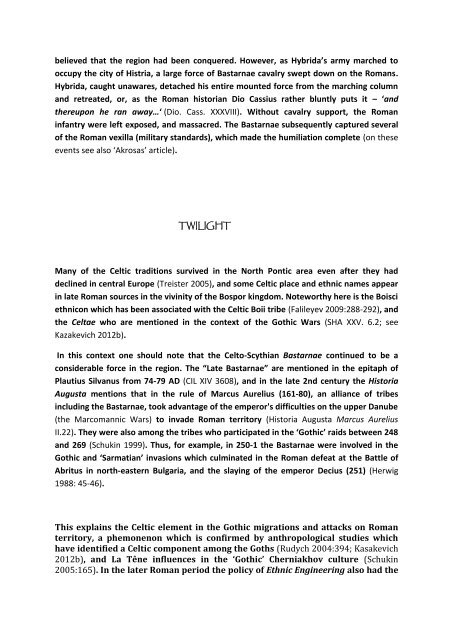gallo-scythians
gallo-scythians
gallo-scythians
You also want an ePaper? Increase the reach of your titles
YUMPU automatically turns print PDFs into web optimized ePapers that Google loves.
elieved that the region had been conquered. However, as Hybrida’s army marched tooccupy the city of Histria, a large force of Bastarnae cavalry swept down on the Romans.Hybrida, caught unawares, detached his entire mounted force from the marching columnand retreated, or, as the Roman historian Dio Cassius rather bluntly puts it – ‘andthereupon he ran away…‘ (Dio. Cass. XXXVIII). Without cavalry support, the Romaninfantry were left exposed, and massacred. The Bastarnae subsequently captured severalof the Roman vexilla (military standards), which made the humiliation complete (on theseevents see also ‘Akrosas’ article).TWILIGHTMany of the Celtic traditions survived in the North Pontic area even after they haddeclined in central Europe (Treister 2005), and some Celtic place and ethnic names appearin late Roman sources in the vivinity of the Bospor kingdom. Noteworthy here is the Boisciethnicon which has been associated with the Celtic Boii tribe (Falileyev 2009:288-292), andthe Celtae who are mentioned in the context of the Gothic Wars (SHA XXV. 6.2; seeKazakevich 2012b).In this context one should note that the Celto-Scythian Bastarnae continued to be aconsiderable force in the region. The “Late Bastarnae” are mentioned in the epitaph ofPlautius Silvanus from 74-79 AD (CIL XIV 3608), and in the late 2nd century the HistoriaAugusta mentions that in the rule of Marcus Aurelius (161-80), an alliance of tribesincluding the Bastarnae, took advantage of the emperor's difficulties on the upper Danube(the Marcomannic Wars) to invade Roman territory (Historia Augusta Marcus AureliusII.22). They were also among the tribes who participated in the ‘Gothic’ raids between 248and 269 (Schukin 1999). Thus, for example, in 250-1 the Bastarnae were involved in theGothic and ‘Sarmatian’ invasions which culminated in the Roman defeat at the Battle ofAbritus in north-eastern Bulgaria, and the slaying of the emperor Decius (251) (Herwig1988: 45-46).This explains the Celtic element in the Gothic migrations and attacks on Romanterritory, a phemonenon which is confirmed by anthropological studies whichhave identified a Celtic component among the Goths (Rudych 2004:394; Kasakevich2012b), and La Têne influences in the ‘Gothic’ Cherniakhov culture (Schukin2005:165). In the later Roman period the policy of Ethnic Engineering also had the


